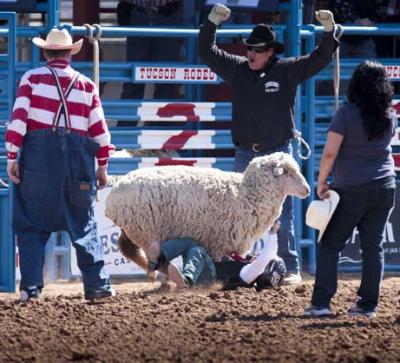
How To Turn Small Boys Into Bull Riders Using Only Everyday Farm Animals

On Saturday, February 18th, your National Rodeo Correspondent left home and hearth to brave the seventy-degree temperatures and clear skies of Tucson and to attend the 2012 Fiesta De Los Vaqueros on your behalf. What follows is his special report, including editorial comments.
If you’re like me – and I’m pretty confident you’re not – then you may wonder where bull riders come from. I remember watching Bodacious, the Moby Dick of rodeo, head-butt a cowboy back in the nineties, breaking his eye sockets just for starters. I expected the ranks to thin out right them, but it didn’t happen. Nobody ever made the buzzer on that bull, but they kept on coming, and it looks like they always will.
Cowboys as young as four years old start their careers at PRCA rodeos. These are big rodeos, with bleachers full of enthusiastic fans, and while their suburban peers are learning to play T-ball in front of adoring parents, these young hands are already getting their faces publicly stomped into the dirt by an animal a lot bigger than they are. Rodeo people are just different from city folks.
The event goes something like this: Dad or Mom places the contestant onto the back of a large squirming sheep, who is not in on the game. There is no harness, saddle or other accoutrements to hang on to, only the wool. The gate is kept open to avoid crushing the little tyke in the chute – the sheep always goes for the exit. At the signal sheep and kid are released and the ride lasts until the kid falls off. My cell phone timer isn’t all that accurate, but measurements have shown that the average duration is about 40 milliseconds – roughly the length of a sneeze.
The "post ride" may last a bit longer than the actual ride. That is the part where the kid hangs on and gets dragged a ways. No balance required, just don’t let go. Often this leads to the sheep being on top. Surprisingly, some young riders find this thrilling and look forward to it. Less surprisingly, others don’t.
"I TOLD you I wouldn’t like it, Mom, and I DON’T LIKE IT!" I heard one mutton buster exclaim as he was trying to clean arena dirt from his tongue through the grill on his helmet. "You’ll do better next time, Son," Mom answered. "Anyway, I liked it."
I asked five-year-old Number 7 Remíjio Obregón about his experience. "I ain’t scared of no sheep. I’ll ride that sucker all day long next time. That sheep better be scared of ME next time. I ain’t gonna fall off again." This is the attitude that makes a bull rider.
Unlike other professional sports, every rodeo is divided up into age classes as well as events that are usually men only, usually women only or both men and women. I say "usually" even though actually it’s always, but as far as I know there’s no rule. I just never saw a man do barrel racing or a woman bust a bronc, so I don’t ever expect to see that. But it could happen. It’s more that rodeo is a tradition of centuries and those things tend to stick.
After the Mutton Busters event, the older contestants get a chance. One event that I hadn’t seen for a while was the staked goat tie. A young goat is staked to the center of the arena. A teenage girl mounted on a fast horse rides toward it at speed, dismounts at a sprint, grabs the goat by the feet and ties its legs together. If the goat stays tied for 5 seconds, the rider has qualified and will be awarded points based on speed, style, etc.
This event has an almost biblical symbolism to it. The whole scene of a small collared goat tied to a stake, surrounded by excited rodeo fans and watching in sudden horrified anticipation as a mounted girl jumps off her galloping horse and runs up with a rope – well that would scare hell out of ME! It’s not a real sacrifice this time, but goats have seen stuff like this before.
Biffle French is a photographer, author and the National Rodeo Correspondent for The Loop.
- Login to post comments
